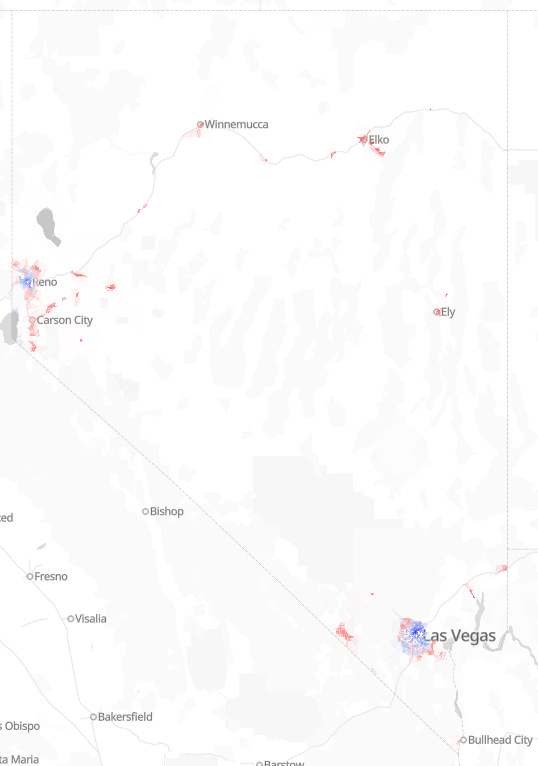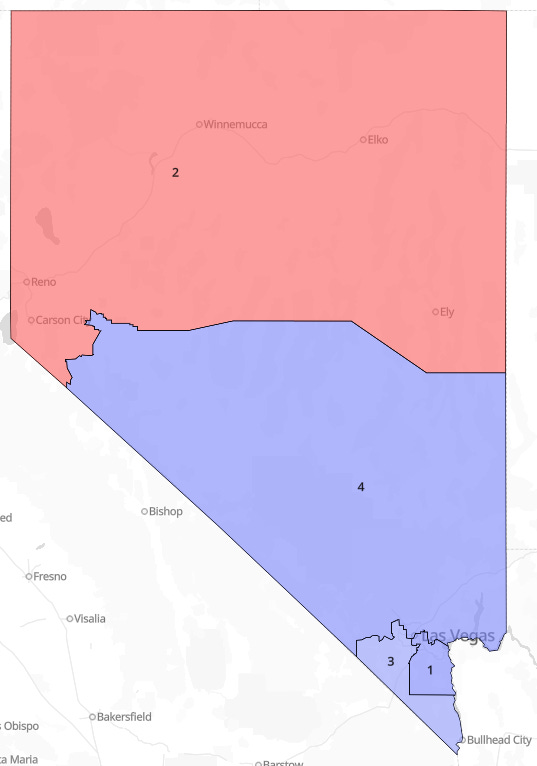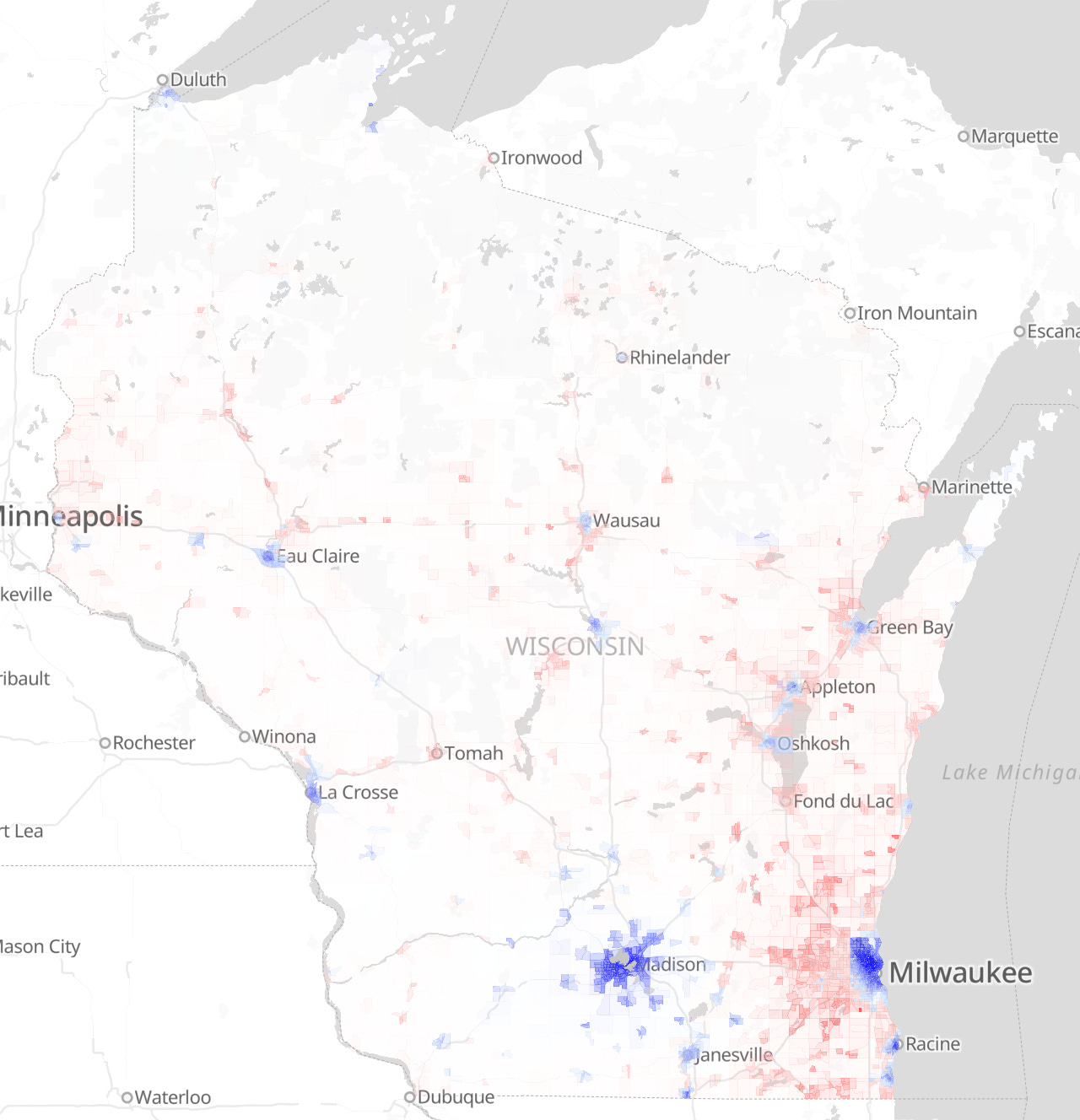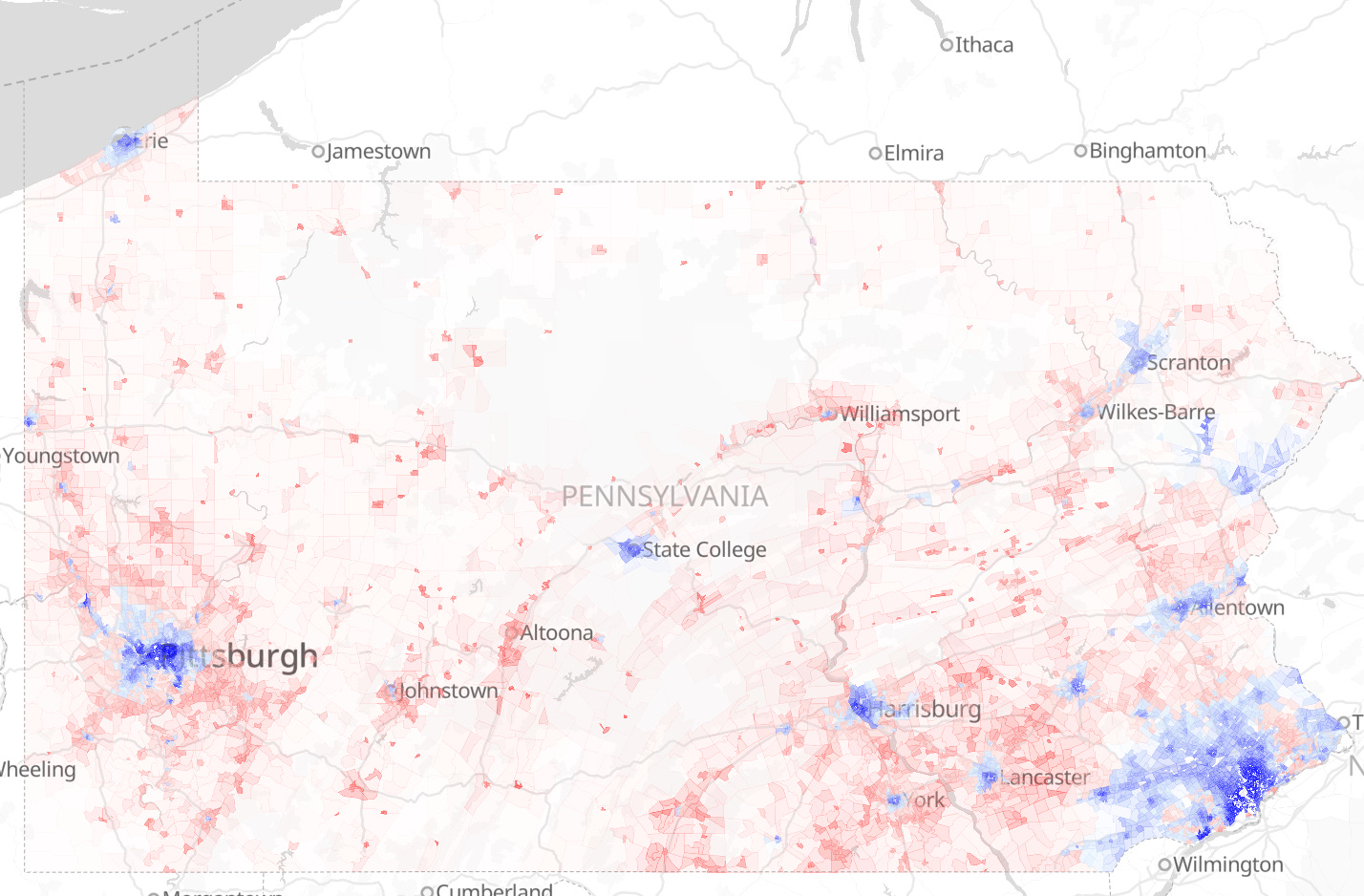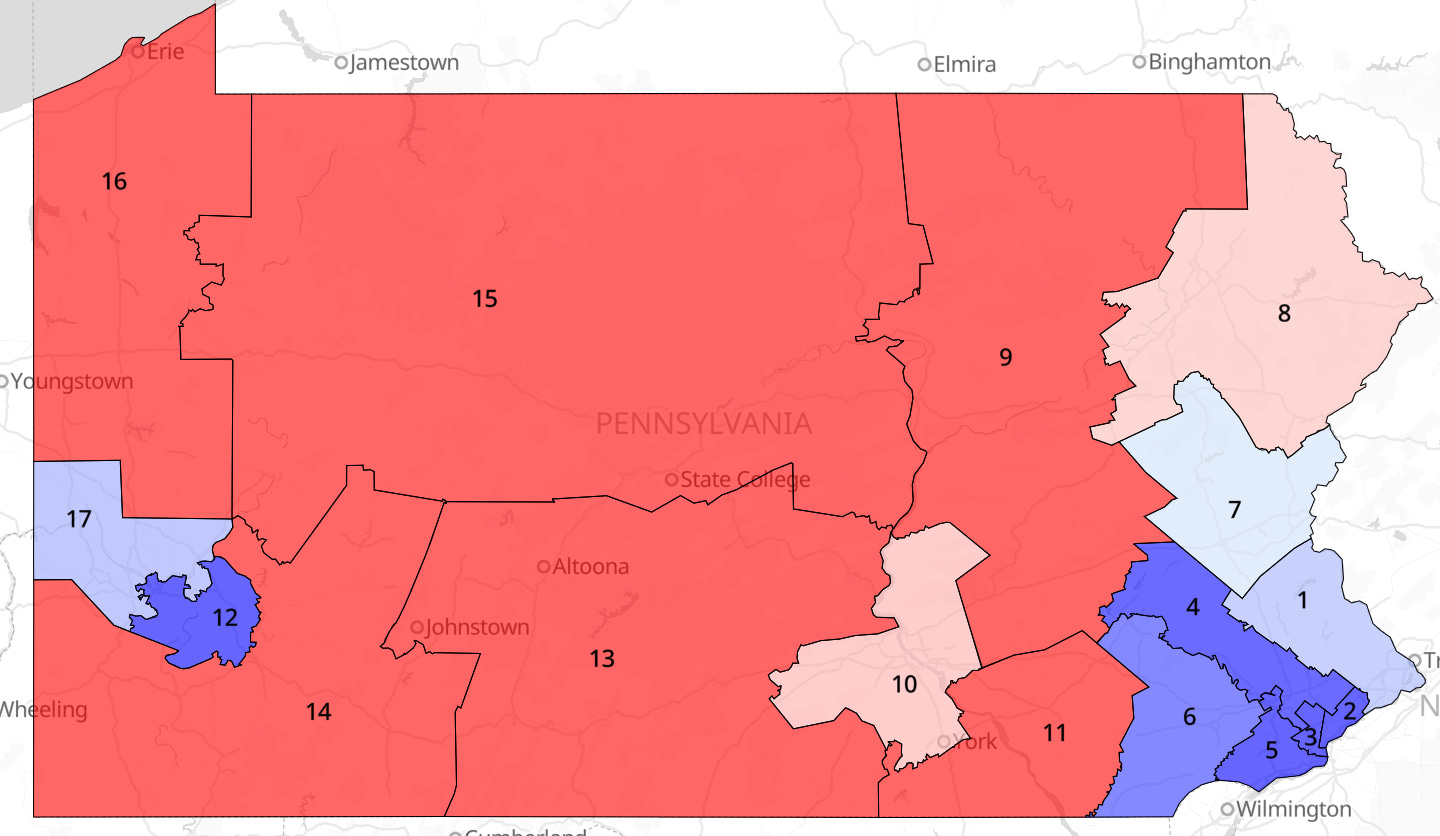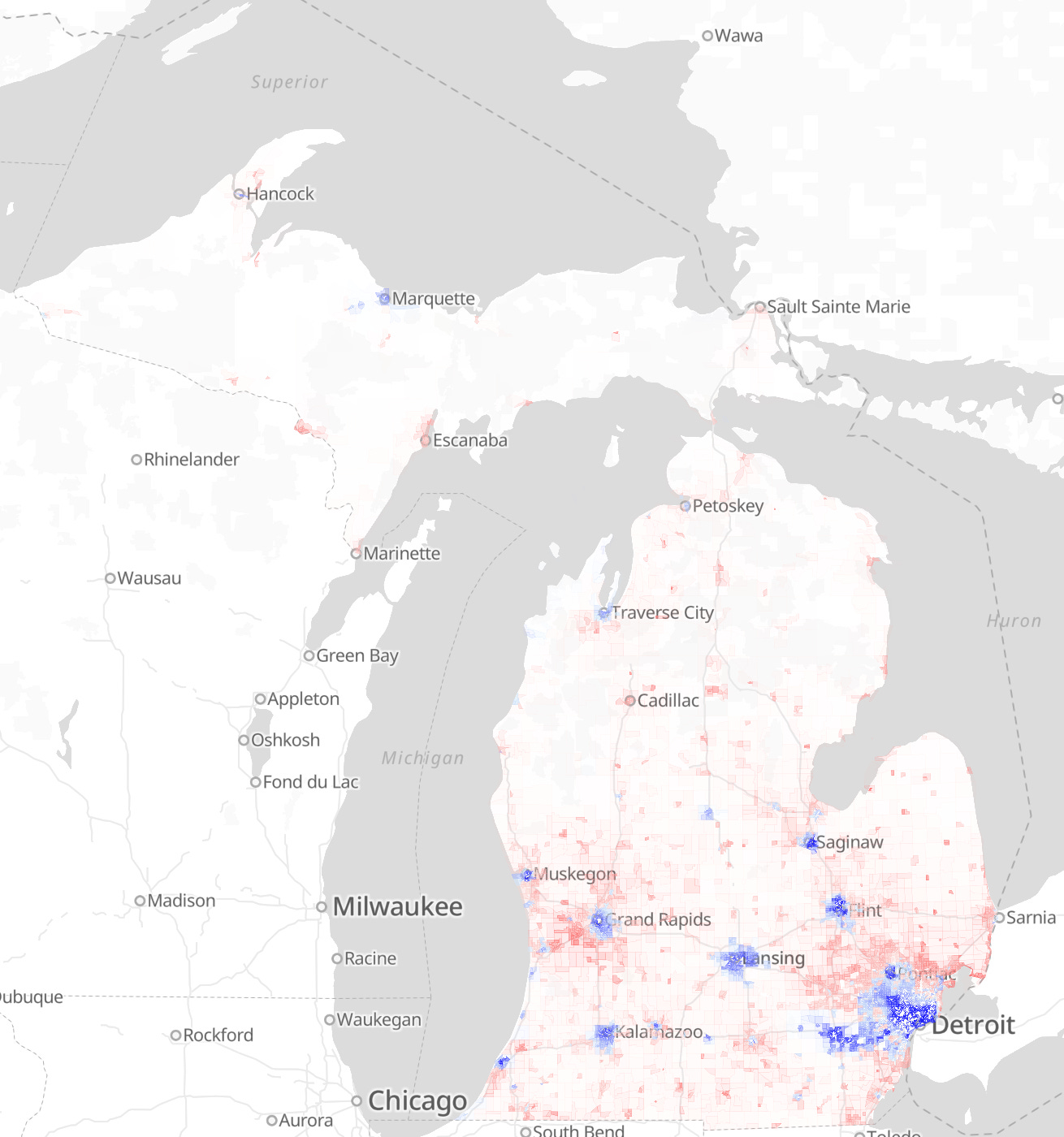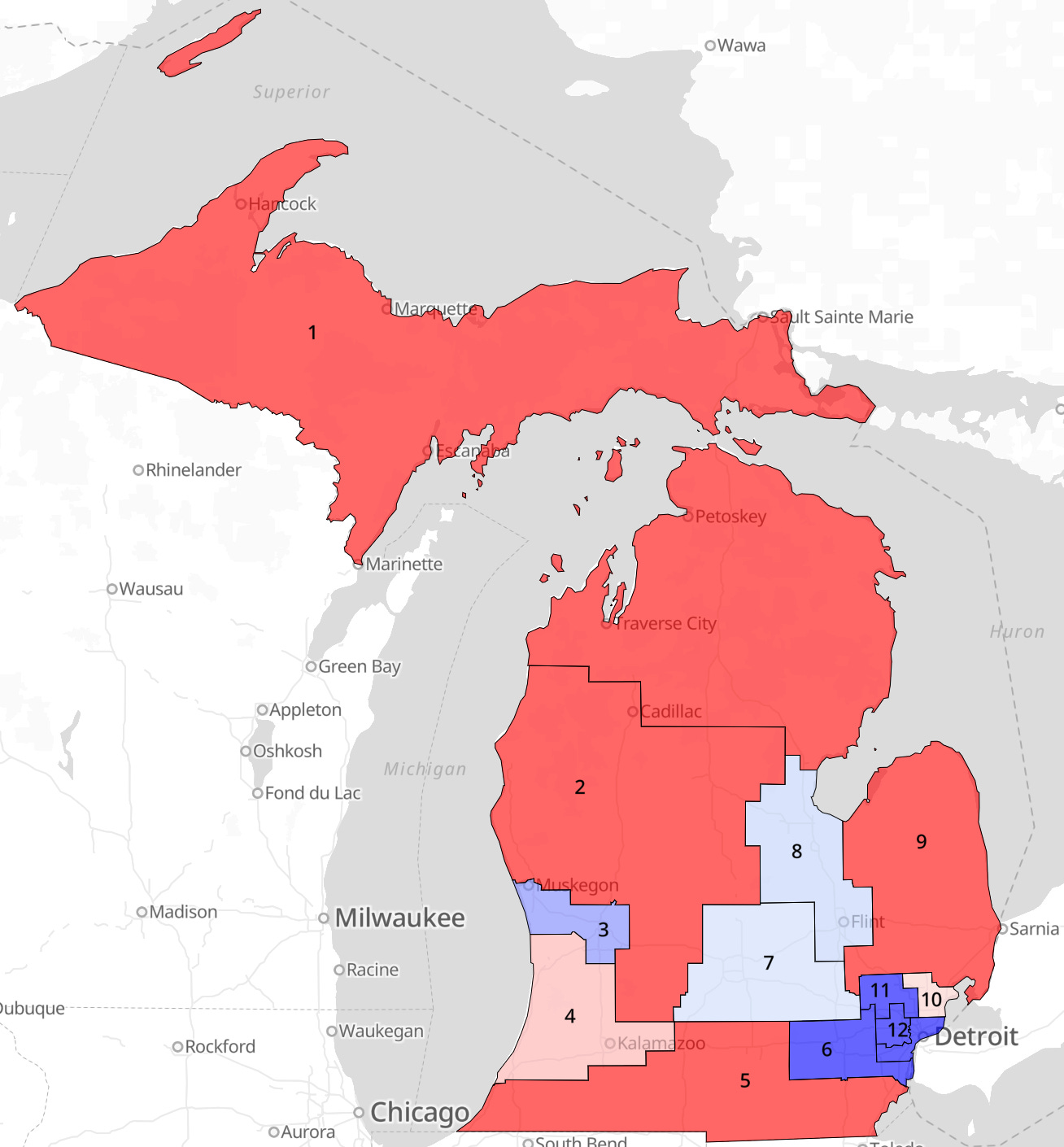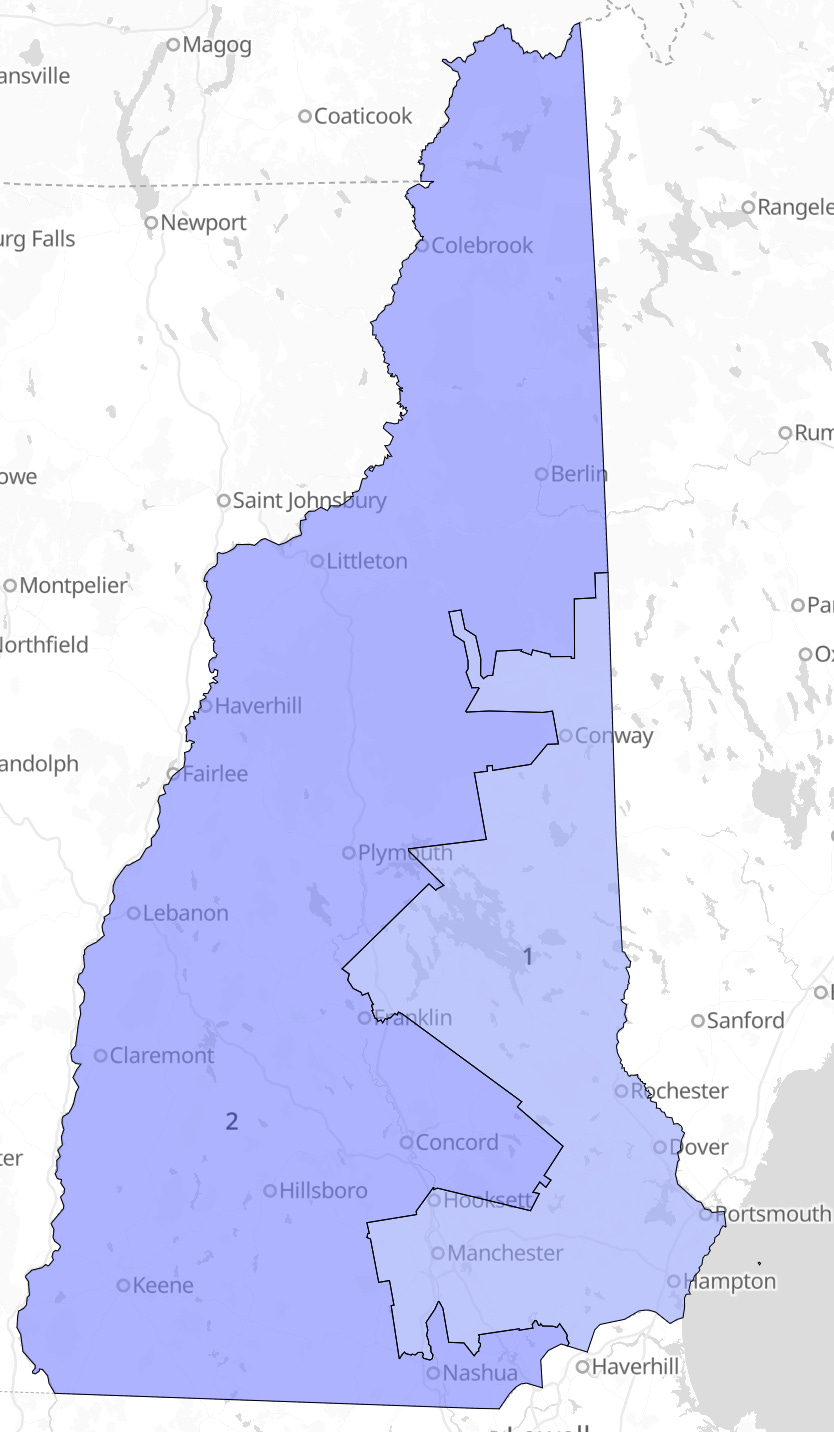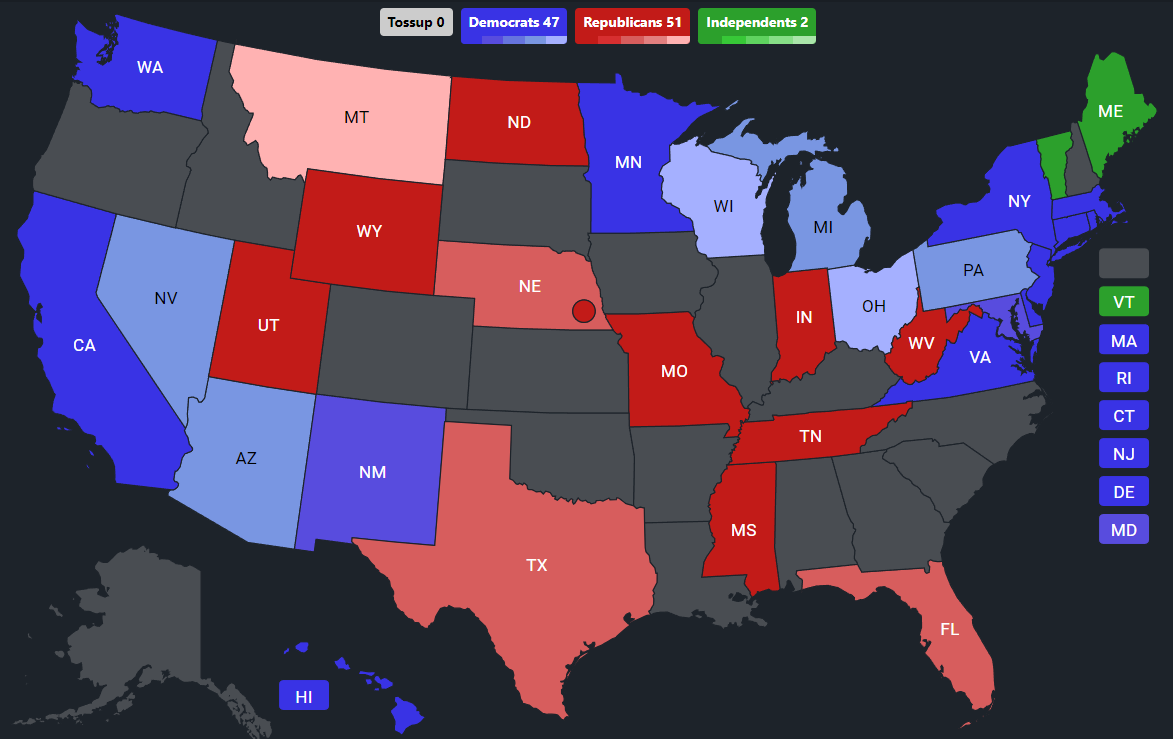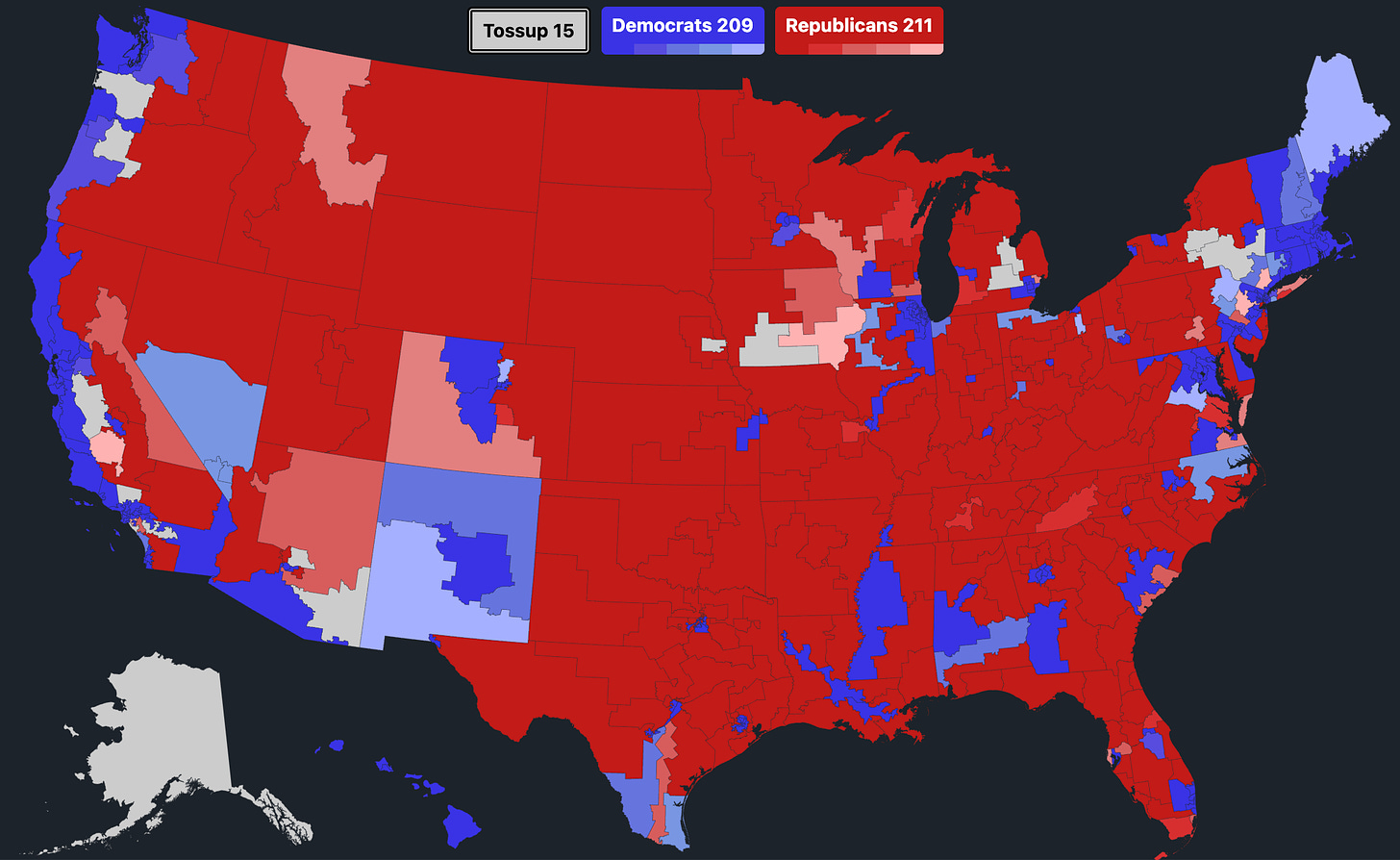Election Watch #26: Election Day Countdown - Days 7 to 1
Today's newsletter is the final installment in Election Watch's countdown to Election Day, going over the seven most competitive states in the 2024 elections.
Heads up: this post is too long for email, so if you want to read the entire thing, you’ll have to follow the link to its Substack page. Otherwise, I hope you enjoy!
The 7 states covered in today’s installment of Election Watch (light green) and the states already covered (dark green).
The 2024 general election is just one week away. This is truly the home stretch for every campaign, and here at Election Watch we are examining the seven most competitive states this year, all of which will be instrumental to deciding the next President of the United States, which party controls majorities in Congress, and more.
(Also, a very brief correction from last week: North Carolina has voted for a Democratic presidential nominee twice since 1964 - once for Carter in 1976 and once for Obama in 2008. I mistakenly forgot about Carter when writing last week’s installment)
The Election Watch Prediction Contest
In case you missed it yesterday, Election Watch’s official 2024 Prediction Contest is live! Anyone can enter for the chance to win a $50 Amazon gift card. To enter, just follow the button or link below and fill out the Google Form. The entry window will close at 11:59pm Eastern on Monday, November 4.
Manual link to the form (in case the button doesn’t work): https://forms.gle/PAqnR552Au5sDKsN7
Day 7: Nevada
A vote density map of the 2020 election in Nevada.
Nevada’s 4 congressional districts, shaded by winning margins in the 2020 presidential election.
President: Nevada has effectively been a swing state since 1992. The vast majority of the state’s population lives in just the Las Vegas and Reno metros, and the state is almost exactly evenly split - Clinton and Biden each won here by 2 points, with Biden losing among Hispanic voters but gaining with White voters. While Vice President Harris may have stemmed the flow of Hispanic voters moving away from Democrats, polling in this state has remained extremely close. Any small demographic shift could drastically change the outcome of the presidential race here. As of today, the race for Nevada’s 6 electoral votes is a pure 50/50 Toss-Up.
Senate: Democratic Senator Jacky Rosen is running for a second term this year. Republicans had initially viewed this race as a prime opportunity to flip a Senate seat, but it seems not to be playing out that way. Rosen has a 4-to-1 fundraising advantage over Brown and has led (or tied) in every single poll taken of this race to date. She leads by an average of 5-8 points and remains the slight favorite to win re-election.
House: Democrats in the Nevada legislature gerrymandered the state’s congressional map to create 3 blue districts and 1 red district by splitting the city of Las Vegas. While the three blue seats aren’t overwhelmingly blue - only ranging from Biden+7 to Biden+9 - they’re blue enough that each of their Democratic incumbents remain slightly favored to win re-election. Dina Titus has potentially the most competitive race of the three in District 1 (her Republican opponent is close to her in funds raised), but all three Democrats remain slight favorites. Popular Republican Mark Amodei in District 2, meanwhile, is the safe favorite to win re-election.
Others: Voters in Nevada are also electing 4 of the 13 seats on the Nevada State Board of Regents and all 4 elected seats on the Nevada State Board of Education. The entire state House and half of the state Senate are up for election as well, with Democrats safely favored to retain their Senate majority (and likely to win a Senate supermajority) and likely to keep their House majority. 3 seats on the Nevada Supreme Court are also up for election, but all three incumbent justices are running for re-election unopposed. Nevada voters are also being asked to weigh in on 7 ballot measures: one to remove the constitutional status of the Board of Regents and thus make it reviewable by the legislature; two to revise/repeal outdated language in the state constitution; one to amend the state sales tax; one to require voters to present a photo ID in order to vote; one to provide for a state constitutional right to abortion before fetal viability; and one to establish top-five primaries and ranked-choice voting for federal and state offices in Nevada (which voters approved in 2022 but must approve again this year in order for it to go into effect).
President: Toss-Up (6 EVs)
Senate: Leans Democratic Hold
House: Safe Republican Hold (District 2); Leans Democratic Hold (Districts 1, 3, 4)
Day 6: Alaska
A vote density map of the 2020 election in Alaska.
President: Since it became a state, the Last Frontier has voted for a Democratic presidential nominee only once, in 1964. But over the last 24 years, it has steadily trended leftwards. That’s because, while much of the state is rural, most of its population lives in Anchorage and its suburbs, which have been rapidly trending leftwards. Add to that the support that Democrats typically receive from Alaska Natives in the Bush (rural Alaska), and state Democrats here have recently become a fairly powerful political force. While George W. Bush won by 31 points in 2000, Trump won by just 10 in 2020. Republicans still see strong support in the Mat-Su Valley just north of Anchorage and around Fairbanks up in the middle of the state, and Trump remains likely to win Alaska and its 3 electoral votes. But the state’s continued leftward trend, combined with the potential for it to go to a second round of ranked-choice voting if neither Harris nor Trump receives >50%, has the potential to make things interesting.
House: Democratic congresswoman Mary Peltola is running for a second full term in the U.S. House, and she faces an extremely competitive race against Republican Nick Begich III. The thing making this race difficult to predict is the state’s use of ranked-choice voting: four candidates appear on the general election ballot, and if no candidate receives >50% of the first-choice votes, the candidates with the fewest first-choice votes are eliminated and their voters’ second choices counted. This continues until a candidate crosses 50% of the vote. Peltola faced Begich and his fellow Republican Sarah Palin under this system in a 2022 special and 2022 general election - both times, Begich came in third and was eliminated, with Peltola ultimately winning in the final round against Palin (by 3 points in the special election and 10 in the general). This year, Begich is the only Republican on the general election ballot, and a second Democrat will appear beside Peltola (which some Democrats worry could result in some voters only voting for him and not ranking Peltola at all). While Peltola has a 9-to-1 cash advantage over Begich, this remains a fairly red (albeit leftward-trending) state, and polls (while rare and small) have shown Begich with a very small lead. This election will not only be instrumental for control of the U.S. House majority, but could also have a large impact on a situation where the House is forced to decide the presidential race. This race is currently a 50/50 toss-up.
Others: The entire Alaska legislature is up for election, and it has one of the most unique compositions of any legislature in the country. Both the state House and state Senate are governed by inter-party coalitions. A grand coalition of 9 Democrats and 8 Republicans control the 20-member Senate, and is safely favored to retain its majority this year. 20 Republicans, 1 Independent, and 2 Democrats make up a majority in the 40-seat House, but whether they or the opposite Democrat-led coalition wins a majority this year is a pure 50/50 toss-up. One thing is certain: Alaskan politics will remain intriguing.
Two justices of the Alaska Supreme Court are also running in retention elections. Both were appointed by a Republican governor, and 4 of the 5 justices on the court as a whole were appointed by Republican governors. Voters will also see two ballot questions this year: one to raise the state minimum wage to $15 an hour and require employers to provide earned paid sick leave for employees; and one which would repeal Alaska’s top-four ranked-choice voting system if approved.
President: Likely Trump (3 EVs)
House: Toss-Up
Day 5: Wisconsin
A vote density map of the 2020 election in Wisconsin.
Wisconsin’s 8 congressional districts, shaded by winning margins in the 2020 presidential election.
President: Wisconsin has been a true swing state in every sense of the word for the past 8 years. In 2016, it was one of three states (alongside Michigan and Pennsylvania) which put Donald Trump over the top in the electoral college, and in 2020 it was the tipping point state that pushed Biden past 270 electoral votes. Both years, the winning candidate won the Badger State by an extremely narrow margin - 0.8 points for Trump in 2016 and 0.6 points for Biden in 2020. Democratic support comes mainly from the state’s biggest cities of Milwaukee and Madison, but with such close margins, things like losses for the party among Black voters or college town liberals upset with the war in Gaza staying home could easily tip the state. Republicans, meanwhile, find most of their support in the Milwaukee suburbs and the rest of the otherwise rural state, but their margins in those suburbs have been slipping in recent years. All of this, combined with polls showing an extremely tight race between Harris and Trump, make the contest for Wisconsin’s 10 electoral votes a pure 50/50 toss-up.
Senate: Incumbent Democrat Tammy Baldwin is running for a third term against Republican Eric Hovde. Baldwin was initially the heavy favorite to win, and for much of this year, she retained at least a slight advantage in the race. In recent weeks, however, polls have shown a suddenly tightening race. Baldwin still retains a consistent lead in almost every poll, but the margin is extremely tight. While Baldwin is a pretty popular and a well-established incumbent with a nearly 10-to-1 cash advantage over Hovde (if you don’t include the $13 million he loaned himself), it appears like her fate is going to be tied to Harris’s in America’s Dairyland, with maybe a point or two of wiggle room. For now, given the toss-up nature of the presidential race here, that makes Baldwin only the very slight favorite to win re-election.
House: Republicans gerrymandered Wisconsin’s 8 congressional districts fairly easily, grouping almost all of the state’s left-leaning voters into just two seats and leaving the other six fairly red. That doesn’t mean there’s no competition this year, though - Districts 1 and 3 are at least somewhat competitive. In District 1, Republican Bryan Steil is likely to win, but one poll showing a somewhat close race in this Trump+2 seat seems to have worried national Republicans, who funneled some money into the race to help him in recent weeks. And in District 3, Republican incumbent Derrick Van Orden seems to be facing a pretty competitive challenge from Democrat Rebecca Cooke, who has kept close in fundraising and been very close in recent polls. This remains a fairly unmoving Trump+5 seat, and Van Orden is still the slight favorite, but Cooke has the potential to pull off an upset here next week.
There is also a somewhat interesting race going on in Trump+15 District 8, where Democratic OB/GYN Kristin Lyerly has raised quite a bit more money than Republican gas station owner Tony Wied. Wied should still win this race in a very red seat, but the fundraising disparity makes him just very likely, rather than the safe favorite, to win. There is also a simultaneous special election for this seat, which is currently vacant, to fill out the rest of the present term until January. The outcome of both races should be the same.
All other incumbents are safely favored to win re-election.
Others: The entire Wisconsin state House and half of the state Senate are up for election this year, and things are pretty interesting. Until this year, Wisconsin’s legislative maps were heavily gerrymandered to benefit Republicans. But a newly liberal state Supreme Court tossed the old maps and implemented new ones which actually make both chambers of the legislature highly competitive. While Republicans are safely favored to keep their Senate majority this year because of which seats are up for election, Democrats are very likely to break their supermajority in the chamber. And Democrats are also favored to pick up a number of seats in the House - enough to the point that Republicans are only very slightly favored to retain their majority in the chamber. Wisconsinites will also see one question on their ballot, which would prohibit the state and local governments from allowing noncitizens to vote if approved.
President: Toss-Up (10 EVs)
Senate: Tilts Democratic Hold
House: Safe Republican Hold (Districts 5-7); Safe Democratic Hold (Districts 2, 4); Very Likely Republican Hold (District 8); Likely Republican Hold (District 1); Leans Republican Hold (District 3)
Day 4: Pennsylvania
A vote density map of the 2020 election in Pennsylvania.
Pennsylvania’s 17 congressional districts, shaded by winning margins in the 2020 presidential election.
President: The Keystone State is - appropriately - viewed as the key to both presidential campaigns’ paths to the White House. Pennsylvania is the largest swing state this year, with 19 electoral votes truly up for grabs. Margins here are narrow - Trump won the state by 0.7 points in 2016 and Biden won it by 1.2 points in 2020 - and both the Harris and Trump campaigns have spent tens of millions of dollars in ads, criss-crossing the state and holding rallies over the past several months. While Harris could continue to improve with White suburban voters around Philadelphia and Pittsburgh, as Biden did, Trump has very strong support among rural Pennsylvanians and could close any gap that Harris opens by making up ground among Black voters in Philadelphia. Polls continue to show an incredibly tight race here, and the presidential contest for Pennsylvania, its 19 electoral votes, and potentially the Presidency, is a 50/50 toss-up.
Senate: Democratic Senator Bob Casey Jr. is running for a fourth term against Republican Dave McCormick. Casey is a pretty popular and well-established incumbent - he has out run other Democrats in the past and won his last election in 2018 by 13 points (albeit during a blue wave). But this year, polling has tightened. Casey only leads McCormick by a narrow margin, and will probably only over perform Harris’s numbers by a few points. Because of his 2-to-1 fundraising advantage and incumbency advantage, Casey is slightly favored to win, but this race continues to tighten before election day.
House: Pennsylvania’s court-drawn congressional map has a good number of competitive seats. This year, 5 see close contests on the House level. In District 1, Republican incumbent Brian Fitzpatrick is likely to win. While it is a leftward-trending Biden+5 seat, Fitzpatrick is an extremely popular incumbent who has won plenty of tough races in this otherwise Democratic area. Add in his cash advantage, and while there haven’t been any good public polls in this race, he remains likely to win. Likewise, over in District 17 on the other side of the state, Democrat Chris Deluzio is also likely to win re-election in this leftward-trending Biden+6 seat with his 3-to-1 cash advantage and favorable demographics.
Some more competitive races are also taking shape over in eastern Pennsylvania. In District 7, Democrat Susan Wild barely scraped by in her 2022 re-election fight, but this year she has a 7-to-1 cash advantage over her Republican opponent and is slightly favored in a district that only went for Biden by 0.6 points. So long as Harris doesn’t lose this district by more than a point or two, Wild should be fine. And in District 10, Republican Scott Perry seems to be facing a serious challenge from Democrat Janelle Stelson, who has raised more money than him and kept polls very close. Still, even though this was only a Trump+4 district that’s zooming leftward, Perry has had strong cross-ballot appeal in the past and remains the slight favorite to win re-election. And finally, the race in District 8 is very close, with incumbent Democrat Matt Cartwright running for re-election in a Trump+3 district. Cartwright has won three races in Trump-friendly territory now, and has out fundraised his Republican opponent 2-to-1, but he remains vulnerable in Republican-friendly territory. Still, Cartwright’s history of strong cross-ballot appeal makes him at least the very slight favorite to win re-election.
Others: Pennsylvanians will also be electing their Attorney General, Auditor, and Treasurer this year, as well as their entire state House and half of their state Senate. Both chambers in the legislature are pretty competitive this year, though Republicans have the advantage in both - they are slightly favored to keep their state Senate majority and very slightly favored to flip the state House to GOP control.
President: Toss-Up (19 EVs)
Senate: Leans Democratic Hold
House: Unopposed Democratic Hold (District 3); Safe Republican Hold (Districts 9, 11, 13-16); Safe Democratic Hold (Districts 2, 4-6, 12); Likely Democratic Hold (District 17); Likely Republican Hold (District 1); Leans Democratic Hold (District 7); Leans Republican Hold (District 10); Tilts Democratic Hold (District 8)
Day 3: Michigan
A vote density map of the 2020 election in Michigan.
Michigan’s 13 congressional districts, shaded by winning margins in the 2020 presidential election.
President: Along with Wisconsin and Pennsylvania, Michigan (my old home state!) used to form the “Blue Wall,” a set of Midwestern “Rust Belt” states that were supposed to guarantee that Hillary Clinton would win the White House in 2016. Instead, the three flipped to Trump that year, and Michigan was the closest among them (Trump won it by just 0.2 points). Of the three states, Michigan voted for Biden in 2020 by the widest margin (2.8 points), but it remains very competitive this year. While Democrats continue to see gains among traditionally Republican-leaning White suburban voters in the state, slight slippage with their traditional base of Black voters in Detroit and serious slippage with Arab American and Muslim voters displeased with Biden’s handling of the war in Gaza could allow Trump to carry the state again. Polls have been swinging back and forth between Harris and Trump, and with so many unknowns, the race to win the Wolverine State and its 15 electoral votes is a pure 50/50 toss-up.
Senate: Michigan has an open Senate race this year, with longtime Democratic Senator Debbie Stabenow retiring. Democrats nominated congresswoman Elissa Slotkin, while Republicans nominated former congressman Mike Rogers (interestingly, they both represented my hometown district in Congress last decade). While both parties initially expected this race to be competitive, it seems to have gone the way of other Senate races in swing states - with Democratic nominees comfortably running several points ahead of Harris. While Rogers has raised $10 million, Slotkin has raised a whopping $40 million and consistently leads Rogers in public polling. With only a week to go until the election, Slotkin is slightly favored to become Michigan’s next Senator, though the same elements that threaten Harris’s coalition in the state could give Rogers an opening.
House: Michigan’s 13 U.S. House districts were drawn by an independent citizens commission that prioritized competitiveness. And several of them are extremely competitive. District 4 is only a Trump+4 seat that is trending leftward, but it votes very Republican down ballot, and incumbent Bill Huizenga is still very likely to win with his significant cash advantage. District 10, on the other side of the state in the Macomb County suburbs, is a Trump+1 seat that’s slightly leftward-trending, but Republican incumbent John James remains slightly favored to win with his a 5-to-1 cash advantage (and the fact that he is running against the same opponent he defeated in 2022). But polls are pretty close in this district, so it could end up competitive in the very end.
Meanwhile, two seats currently held by retiring Democrats are extremely competitive. District 7, which is being vacated by Elissa Slotkin as she runs for Senate, is a Biden+1 seat that’s leftward trending and which has an unpredictable House race this year. Democrat Curtis Hertel Jr. currently has a slight lead in fundraising over Republican Tom Barrett, but there hasn’t been any good public polling in the race, and such a close margin at the top of the ballot four years ago makes this a 50/50 toss-up. A similar situation is playing out in District 8, where popular Democrat Dan Kildee is retiring and leaving a Biden+2 but rightward-trending seat open. Democratic nominee Kristen McDonald Rivet and Republican nominee Paul Junge are practically tied in fundraising, but there again hasn’t been any independent public polling in this race and it’s effectively a 50/50 toss-up.
All other incumbents are safely favored to win re-election.
Others: Michiganders will also be electing 2 of the 8 seats on each of the State Board of Education, University of Michigan Board of Regents, Michigan State University Board of Trustees, and Wayne State Board of Governors. The entire state House is also up for election. Democrats currently hold a 1-seat majority, and the contest for the majority this year is extremely competitive. State legislative forecast CNalysis, in fact, believes that this year’s elections will result in a tie in the state House, with each party winning 55 seats. Such an outcome would force the two parties to reach a power-sharing agreement. Two seats on the Michigan Supreme Court are also up for election. Democrats hold a 4-3 majority on the Court, meaning that Republicans could flip control of the Court if they win both seats this year, or Democrats could win a supermajority if they carry both.
President: Toss-Up (15 EVs)
Senate: Leans Democratic Hold
House: Safe Democratic Hold (Districts 3, 6, 11-13); Safe Republican Hold (Districts 1, 2, 5, 9); Very Likely Republican Hold (District 4); Leans Republican Hold (District 10); Toss-Up (Districts 7, 8)
Day 2: New Hampshire
A vote density map of the 2020 election in New Hampshire.
New Hampshire’s 2 congressional districts, shaded by winning margins in the 2020 presidential election.
President: The Granite State is unlike its New England counterparts in that it remains somewhat competitive on the federal level. It has been a swing state throughout the 21st century, though in recent elections it has trended convincingly leftward. New Hampshire is fairly rural, but its demographics rank above the national average in income and college degree attainment, meaning it is increasingly friendly to Democrats in today’s party politics. While Hillary Clinton only won this state by 0.4 points in 2016, President Biden carried it by 7 points in 2020, and Vice President Harris seems poised to win it by a roughly similar margin this year. Harris is likely to win New Hampshire and its 4 electoral votes.
Governor: While New Hampshire may be leaning more and more towards Democrats on the federal level, things on the state level are another story altogether. Like its neighbor Vermont, New Hampshire has a very popular moderate Republican governor who consistently outruns other Republican candidates by large margins. Governor Sununu, however, is retiring this year, and the race to replace him is anyone’s for the taking. Republicans nominated former U.S. Senator Kelly Ayotte, while Democrats picked former mayor of Manchester Joyce Craig. Polling in the race had been relatively scarce until recently, but it now shows Ayotte with a narrow lead more often than not. She has also raised 3 times as much money as Craig. But this is still a very close race in an otherwise blue-leaning state, and anything can happen over the next week. For now, the race is a toss-up, but expect a rating change one way or the other in next week’s newsletter.
House: New Hampshire has two congressional districts, both of which roughly mirror the state’s margins as a whole. Because the state leans blue on the federal level, both districts are likely to elect Democratic candidates again this year. Incumbent Democrat Chris Pappas in District 1 and Democrat Maggie Goodlander in the open District 2 both have solid leads in polling and money, and are likely to win their races.
Others: Along with Governor, New Hampshirites will also be electing all 5 seats on the Executive Council, which has oversight over the state budget and gubernatorial appointments and pardons. It’s currently controlled by a 4-to-1 Republican majority.
The entire New Hampshire legislature is also up for election, and it is a doozy. The state has the largest state legislature in the country - its state House is 400 members strong, which breaks down to 1 representative for every 3,506 residents. That also makes it extremely difficult to predict. Nonetheless, Republicans currently hold an extremely narrow majority in the chamber, but Democrats are very slightly favored to win their own majority this year. The fight to control a majority in the much smaller state Senate, however, remains a pure 50/50 toss-up.
Voters will also weigh in on one ballot measure, which would increase the mandatory judicial retirement age from 70 to 75 if approved.
President: Likely Harris (4 EVs)
Governor: Toss-Up
House: Likely Democratic Hold (Both seats)
Day 1: Arizona
A vote density map of the 2020 election in Arizona.
Arizona’s 9 congressional districts, shaded by winning margins in the 2020 presidential election.
President: Arizona is the #1 all-around most competitive state this year, fueled in no small part by the presidential contest. Arizona has been a swing state for several election cycles now, having steadily moved from Republican stronghold to swing state status over the past several election cycles. While Mitt Romney won the state by 9 points in 2012, President Trump’s margin fell to just 3.5 points in 2016, and President Biden won it by a very narrow 0.3 points in 2020 (it was the closest state by raw vote margin that year). The state also saw extremely competitive statewide elections for Governor and Senator in 2022, both of which Democrats won, and was long expected to be highly competitive again this year. Trump has led Harris in polling in the Grand Canyon State for weeks, albeit by very narrow margins. Recent polls released this past week have shown a tied race more often than not. Harris will have to rely on continuing to win over White suburban voters in Phoenix and Tucson while not slipping with voters of color, while Trump is counting on supercharged rural turnout while mitigating his losses in the suburbs and chipping away at Harris’s numbers with Black and Hispanic voters. Right now, polling paints Trump as the very slight favorite, but that’s well within a slight polling error, and anything can happen over the next week. Trump is very slightly favored to win Arizona and its 11 electoral votes - for now.
Senate: Arizona’s Senate race this year is a different story. Independent Senator Kyrsten Sinema is retiring, and Democrats nominated congressman Ruben Gallego to replace her. Republicans had initially hoped that this race would be competitive, but it appears to be slipping further and further away from them. GOP voters nominated Kari Lake, an ardent election denier who lost the 2022 gubernatorial election here (though she still claims she is the rightful Governor of Arizona). To put things simply: voters do not like Kari Lake because she is so extreme. Gallego has led her in every single poll taken since early August and has raised more than $53 million to her $19 million. Arizona is still a very close state, so Lake has a path to victory, but Gallego is clearly at least slightly favored to win the seat and hold* it for Democrats.
*Sinema is an Independent but caucuses with Senate Democrats.
House: Arizona’s 9 congressional districts are not gerrymandered, though Republicans do have a little bit of an advantage. Democrats and Republicans are safely favored in 3 seats each, and the remaining 3 are all at least a little competitive. District 2 in the state’s north voted for Trump by 8 points in 2020, but Republican incumbent Eli Crane has drawn a strong challenge from Democrat Jonathan Nez, the former President of the Navajo Nation. Nez has raised more than $4 million (though Crane still has $7 million), and one very small poll had this race tied. Crane still retains the advantage in incumbency, favorable turf, and cash, and remains likely to win re-election, but this could be a race to watch.
Things are extremely close in Districts 1 and 6, where Republican incumbents David Schweikert and Juan Ciscomani face Democratic challengers who have kept even with them in fundraising in rapidly leftward-trending areas. Schweikert has survived highly competitive races in 2020 and 2022, but polling has once again put this as a tied race, and his ability to out perform other Republicans may be coming to an end. Ciscomani is a first-term incumbent, but was able to outrun other Republicans by a large margin in 2022 and faces the same Democratic opponent this year. Still, his Tucson-based district is flying leftward and he is also fighting for his political life. Both races are 50/50 toss-ups.
All other incumbents are safely favored to win re-election, with Democrat Yassamin Ansari the safe favorite to win the open seat in District 3.
Others: Arizonans will also be electing 3 of the 5 seats on the Corporation Commission and the entire state legislature. The fight for legislative control is extremely competitive - Republicans have controlled both the state House and state Senate for more than three decades, but Arizona’s shift to swing state status has made control of both chambers 50/50 toss-ups. Two justices of the Arizona Supreme Court are also up in retention elections; both were appointed by a Republican governor.
There are also 13 ballot initiatives on the Arizona ballot next week. Among them are ones to: limit regulatory rulemaking; allow police to arrest noncitizens on immigration-related suspicions at places other than official ports of entry; require that anyone convicted of child sex trafficking must receive a sentence of life imprisonment; allow for property tax refunds in certain circumstances; establish a $20 fee on every conviction for a criminal offense; allow for tipped workers to be paid 25% less per hour than the minimum wage; end term limits for state supreme court justices and superior court judges, replacing them with terms of good behavior and ending retention elections in most cases; and provide for the legislature to terminate a state of emergency or alter the emergency powers of the governor during the state of emergency. Other ballot initiatives are very closely-watched, though, and those include ones to: require partisan primary elections for partisan offices; create a signature distribution requirement for citizen-initiated ballot measures based on state legislative districts; provide for challenges to an initiative measure or constitutional amendment after the filing of the measure with the secretary of state; provide for a state constitutional right to abortion; require primaries in which candidates, regardless of partisan affiliation, appear on a single ballot and a certain number advance to the general election, and require general election candidates to receive a majority of votes (the first and last ones conflict, so whichever receives more votes will come out on top if both pass).
President: Tilts Trump (11 EVs)
Senate: Leans Democratic Hold*
House: Safe Republican Hold (Districts 5, 8, 9); Safe Democratic Hold (Districts 3, 4, 7); Likely Republican Hold (District 2); Toss-Up (Districts 1, 6)
Forecast Updates
As this is my penultimate newsletter before Election Day, I am reserving most of my last forecast updates for next week’s final 2024 installment. Still, I am making one this week since I covered it in today’s countdown:
AK House: Tilts Democratic Hold to Toss-Up: As mentioned near the top of this installment, Democrat Mary Peltola is facing a very tough challenge from Republican Nick Begich III, and this race is very difficult to predict due to the use of ranked-choice voting, the presence of a second Democrat on the ballot, and very limited public polling.
The Election Watch Presidential Forecast
The Election Watch Gubernatorial Forecast
The Election Watch Senate Forecast
The Election Watch House Forecast
And that’s all for the 2024 Election Watch countdown! Phew! 31,115 words later, and we have covered every state and their elections this year!
Next week, I’m going to give a brief overview of the most important elections to watch on election night, and then…the election will be here.
Make sure you vote or have a plan to vote if you haven’t already, and I’ll see you then!
Upcoming Elections
November 5: 2024 General Election



